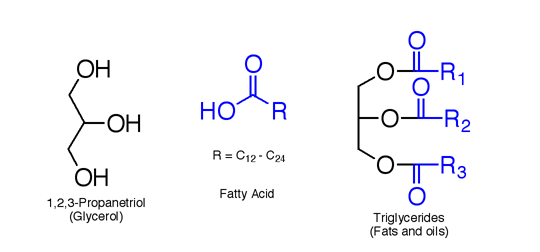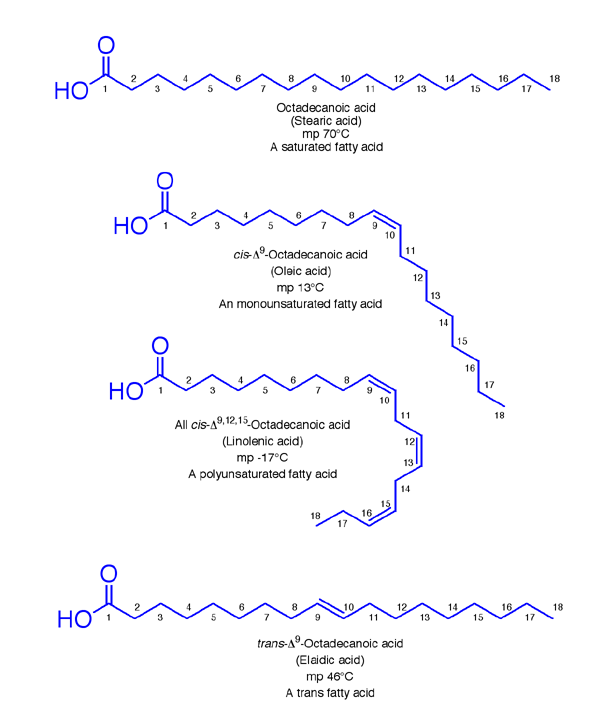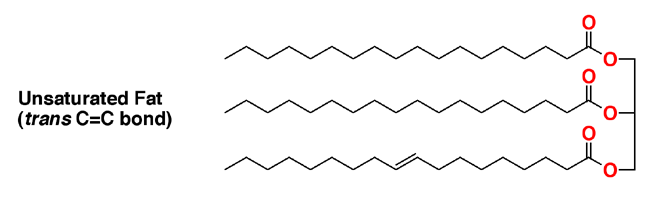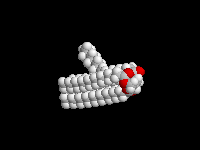




Fats are added to a wide variety of processed foods to provide a desirable firm texture and pleasant taste. To supply the demand for dietary fat of the appropriate consistency, the cis double bonds of vegetable oils are partially hydrogenated. The greater the extent of hydrogenation, the more solid the fat that is produced. Usually a Ni catalyst is used with limiting H2. Under these conditions, due to reversible interaction of the double bond with the Ni catalyst, the double bonds remaining are isomerized to give an equilibrium mixture that favors the more stable trans form. Trans fatty acids have rod-like shapes that pack together relatively well, so they have melting points that are much higher than corresponding unsaturated fatty acids, but lower than corresponding saturated fatty acids.
Heating vegetable oil at high temperatures for extended periods of time, such as occurs for the frying process at fast food restaurants, also leads to equilibration of fatty acid double bonds, generating high concentrations of trans fatty acids in old frying oil. This is usually partially hydrogenated anyway, containing large amounts of trans fatty acids that are transferred in large quantity to the foods cooked in them.
Low overall serum cholesterol and a decreased low density lipoprotein (LDL)-cholesterol to high density lipoprotein (HDL)-cholesterol ratio are associated with good overall cardiovascular health. High overall cholesterol and an elevated LDL-cholesterol to HDL-cholesterol ratio are linked to a high incidence of cardiovascular disease, especially atherosclerosis. Overwhelming research has indicated that diets high in either saturated or trans fatty acids are associated with higher serum LDL-cholesterol to HDL-cholesterol ratios and increased risk of cardiovascular disease. Fried foods such as French fries from fast food restaurants, stick margarine, certain commercial bakery products, crème filled cookies, etc. used to be major sources of trans fatty acids in the diet.
Monounsaturated and polyunsaturated fatty acids do not show similar health
risks in most studies, although too much fat of any kind in the diet can lead
to obesity, a major health problem with associated diseases. Some polyunsaturated
fatty acids, such as those found in certain types of fish, have even been
shown to have beneficial effects in some studies. More than a decade ago, the FDA announced
that processed foods are required to list the amount of trans fatty
acids they contain, so that consumers can make better choices about the food
they eat. A diet low in saturated and trans fatty acids is recommended, along
with more fish, whole grains, fruits, vegetables and especially daily exercise,
which is tremendously beneficial regardless of diet. Fortunately, due to the required labeling, most food manufacturers have removed trans fatty acids from their products, and even fast food restaraunts make sure to avoid trans fatty acids in their frying oil. It will be interesting to see how this change for the better in our diets improves our collective health in the coming decades.
Here are some older original articles concerning dietary fat and associated health problems that helped convince policy makers to change regulations.
A review on dietary fat and serum cholesterol
A nice general review on trans fatty acids